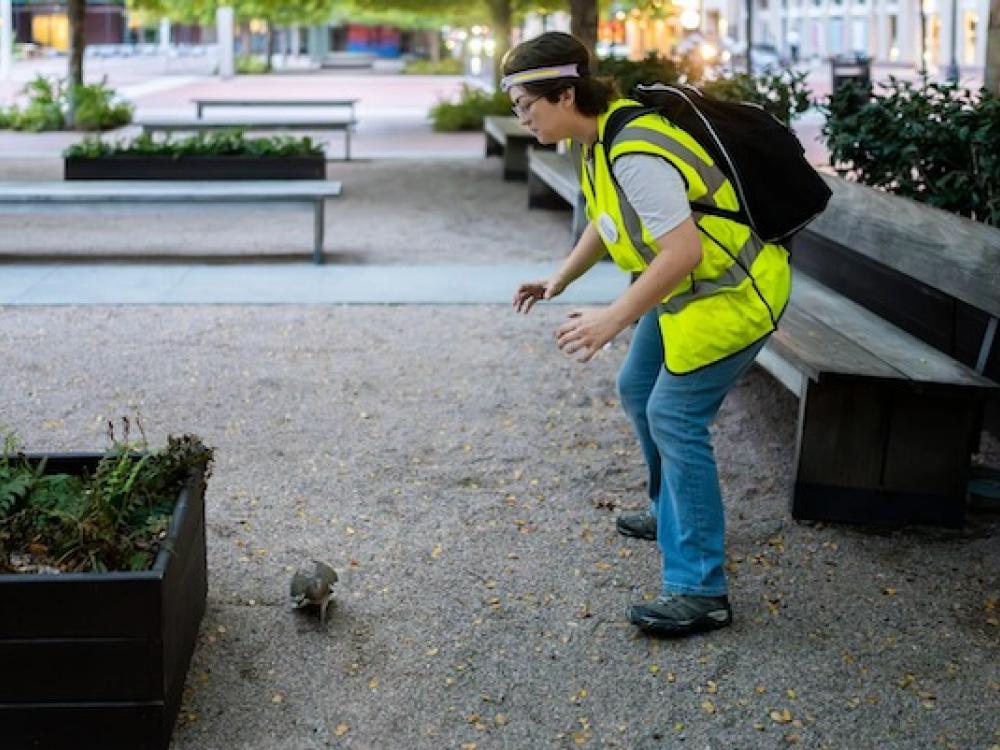
Madison Gover, assistant coordinator for Lights Out Fort Worth, waits to catch an injured bird Sept. 13. The bird was caught as part of a surveying project in downtown Fort Worth. The Texas Conservation Alliance team searches downtowns to document bird deaths caused by flying into tall, reflective buildings. Photo by Cristian ArguetaSoto | Fort Worth Report.
By HALEY SAMSEL AND CRISTIAN ARGUETASOTO, Fort Worth Report
Sept. 17, 2023
Before the sun rises above the downtown Fort Worth skyline, a group outfitted in reflective safety vests emerges from the Tarrant County College parking lot. Armed with flashlights and headlamps, they walk toward their first stop: the Wells Fargo tower on Main Street.
They split into pairings, circling 10 downtown buildings to search for dead and injured birds on street corners or in bushes. Soon, they spot a dead warbler on the sidewalk. Volunteer April Pajoohi crouches to snap a picture before Lights Out Fort Worth coordinator Mariah Campos places the bird into a plastic bag to be sent to Texas A&M’s Biodiversity Research and Teaching Collections lab.
“We’ll pick up any birds we find along the way, and of course, sometimes bats, too,” said Mei Ling Liu, community conservation director for the Texas Conservation Alliance. “Fort Worth is slowly building up the community of people and students. We want students to be aware and we want teachers to work with us to bring more students on this walk.”
The daily survey is Fort Worth’s contribution to the national Lights Out campaign, which encourages building owners and residents to turn off their outdoor lighting between 10 p.m. and 6 a.m. for the entirety of bird migration periods. The spring migration period lasts between March and May, while the fall stretches between September and late November. A similar survey is conducted by Texas Conservation Alliance every spring and fall in downtown Dallas.

Between 365 million and 988 million birds are killed in the U.S. each year when they are pulled into urban areas by light pollution and collide with buildings, according to studies cited by the Cornell Lab of Ornithology. The issue is particularly crucial in Texas, where up to two billion birds travel annually.
“It’s an underseen, underrepresented problem because detection rates are low,” Julia Wang, a project leader for the Cornell Lab, told the Report last year. “Birds are taken away by scavengers, predators and cleaning crews that sweep them away.”
Downtown Fort Worth Inc. members began participating in Lights Out more than two years ago, but the surveying effort only kicked off in the spring under the supervision of the Texas Conservation Alliance, a statewide environmental organization. The program is financially supported by the Amon G. Carter Foundation.

Between April 1 and May 31, Campos and assistant coordinator Madison Gover led a group that counted 85 bird deaths in downtown. They spotted 19 stunned birds and rescued another 20.
The data helps persuade local governments to change their lighting habits — and possibly require bird-friendly glass through new ordinances — by showing the scale of the problem, said Liu, the community conservation director.
“A lot of times, when you talk to people who don’t turn off their lights, when they’ve never seen a bird die after hitting a window, they’ve never seen it as a serious issue,” Liu said. “After they walk with us, they make changes and advocate for the birds. It’s a very simple action people can do, to turn off their lights and close their curtains during those time frames.”

This fall, Campos and Gover are focused on bringing more students into the fold by giving presentations on campuses and signing up more volunteers for the daily survey. Volunteers can join their walk through downtown beginning each morning at 6 a.m. from now through Dec. 1, with the exception of a couple days off for Thanksgiving.
Word of the survey has already spread beyond committed environmentalists. As the group finished up its Sept. 13 canvass, a Sundance Square security staff member flagged down Campos. A bird was injured near the plaza and could use their help, he said. After realizing the bird couldn’t fly, Gover and Pajoohi captured the animal with plans to take it to a clinic in Keller.

Campos knows the group won’t rescue every bird in need of assistance, or document every species killed by a collision. But the campaign is gaining momentum with support from the community, including the city staff who operate street sweepers in the early morning hours, she said.
“We met a few of them downtown, and one said: ‘Hey, y’all are missing a bunch of birds. We can put them in this bush for you,’” Campos said. “We try to get out here to beat the street sweepers, but we can’t get them all.”

Haley Samsel is the environmental reporter for the Fort Worth Report. You can reach them at haley.samsel@fortworthreport.org. Cristian ArguetaSoto is the community engagement journalist at the Fort Worth Report. Contact him by email or via Twitter
This article first appeared on Fort Worth Report and is republished here under a Creative Commons license
RELATED ARTICLES
Migrating bird deaths documented in downtown Dallas
'Lights Out' campaign is gaining momentum, say organizers
Stay up to date on everything green in North Texas, including the latest news and events! Sign up for the weekly Green Source DFW Newsletter! Follow us on Facebook,Twitter and Instagram. Also check out our podcast The Texas Green Report, available on your favorite podcast app.









